- Writing Worksheets and Other Writing Resources
- Thesis, Analysis, & Structure

Thesis Activity
About the slc.
- Our Mission and Core Values

One way to think about a thesis statement is:
An effective thesis is one that is not obvious; rather it is one that is discussible, arguable, and interesting.
Avoid self-evident statements.
In the US, movie stars are greatly admired.
A strong thesis will give readers an idea of the general direction of your paper and the evidence you will provide.
Because definitions of obscenity change as society changes, the Supreme Court has handed down three contradictory decisions on censorship in the past five years.
A few things to keep in mind:
- A thesis must be a complete sentence(s), not a fragment(s).
- A thesis should not be worded as a question.
- A thesis should neither be too broad nor too specific.
- A thesis should not contain elements which are extraneous or irrelevant to your paper.
- A thesis should avoid phrases like I think and in my opinion because they weaken the writer's argument.
Having said all of that, let's venture into never-never land, take a trip to the world of happily-ever-after. Let's look at fairy tales.
Take a common fairy tale. Little Red Riding Hood , for example. Your average tale of good vs. evil, right?
In my opinion, Little Red Riding Hood is a classic tale of good versus evil.
Now, there's a thesis that is sure to keep you up at night. Interesting. Innovative. Imaginative. I think not.
Let's try something else. How about:
Because she dares to defy societal norms of acceptable female behavior, Little Red Riding Hood faces death at the hands of the Big Bad Wolf, who embodies patriarchy.
Little Red Riding Hood serves as a feminist tale, demonstrating how an independent, intelligent woman subverts the entrenched forces of male power and privilege.
The forest in Little Red Riding Hood--with its various elements of danger, fear, and foreboding--symbolizes a young girl's rite of passage into womanhood; by challenging the elements in the forest, the naive and trusting Little Red Riding Hood emerges an empowered, mature, confident young woman.
Television shows and movies also offer a wealth of possible thesis statements. Consider the following:
As the middle child, Jan Brady is insecure and demonstrates a negative self-perception: she feels inferior to Marcia, who embodies the qualities of the "ideal" teenager and to Cindy, the "innocent" child and center of the family's attentions.
While appearing to be a simplistic situation comedy about a group of castaways, Gilligan's Island is actually a complex representation of vice; each of the characters represents one of the seven deadly sins.
While Star Trek : The Next Generation may appear to represent an ideal version of a multicultural, gender-equal society, the command structure on the Enterprise, headed by Picard and Riker, reinscribes western, patriarchal notions of power.
Although praised for its realism, Saving Private Ryan glorifies American patriotism and heroism, excluding alternative perspectives.
Now it is your turn. Construct an interesting, compelling thesis using a fairy tale, television show, popular song, or movie.
Luisa Giulianetti Student Learning Center, University of California, Berkeley ©1998 UC Regents
This work is licensed under a Creative Commons Attribution-NonCommercial-NoDerivs 3.0 Unported License.
Reading Worksheets, Spelling, Grammar, Comprehension, Lesson Plans
How to Write a Thesis Statement
About this worksheet:.
Practice developing thesis statements with this writing introduction worksheet! Students will learn how to improve their writing with a strong, attention grabbing thesis statement. This activity helps build writing skills by asking students to create a statement for the topics provided, such as: “What was the greatest challenge in your life?”.
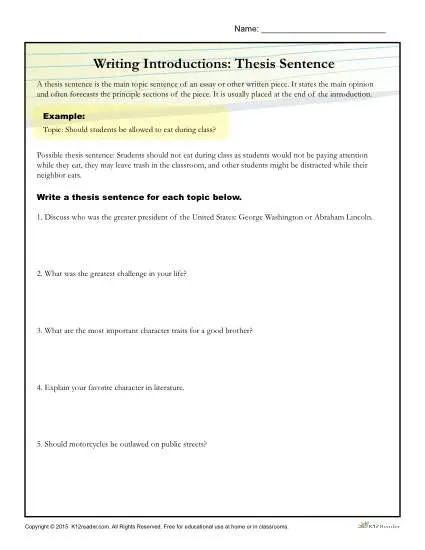

Thesis Statements
What this handout is about.
This handout describes what a thesis statement is, how thesis statements work in your writing, and how you can craft or refine one for your draft.
Introduction
Writing in college often takes the form of persuasion—convincing others that you have an interesting, logical point of view on the subject you are studying. Persuasion is a skill you practice regularly in your daily life. You persuade your roommate to clean up, your parents to let you borrow the car, your friend to vote for your favorite candidate or policy. In college, course assignments often ask you to make a persuasive case in writing. You are asked to convince your reader of your point of view. This form of persuasion, often called academic argument, follows a predictable pattern in writing. After a brief introduction of your topic, you state your point of view on the topic directly and often in one sentence. This sentence is the thesis statement, and it serves as a summary of the argument you’ll make in the rest of your paper.
What is a thesis statement?
A thesis statement:
- tells the reader how you will interpret the significance of the subject matter under discussion.
- is a road map for the paper; in other words, it tells the reader what to expect from the rest of the paper.
- directly answers the question asked of you. A thesis is an interpretation of a question or subject, not the subject itself. The subject, or topic, of an essay might be World War II or Moby Dick; a thesis must then offer a way to understand the war or the novel.
- makes a claim that others might dispute.
- is usually a single sentence near the beginning of your paper (most often, at the end of the first paragraph) that presents your argument to the reader. The rest of the paper, the body of the essay, gathers and organizes evidence that will persuade the reader of the logic of your interpretation.
If your assignment asks you to take a position or develop a claim about a subject, you may need to convey that position or claim in a thesis statement near the beginning of your draft. The assignment may not explicitly state that you need a thesis statement because your instructor may assume you will include one. When in doubt, ask your instructor if the assignment requires a thesis statement. When an assignment asks you to analyze, to interpret, to compare and contrast, to demonstrate cause and effect, or to take a stand on an issue, it is likely that you are being asked to develop a thesis and to support it persuasively. (Check out our handout on understanding assignments for more information.)
How do I create a thesis?
A thesis is the result of a lengthy thinking process. Formulating a thesis is not the first thing you do after reading an essay assignment. Before you develop an argument on any topic, you have to collect and organize evidence, look for possible relationships between known facts (such as surprising contrasts or similarities), and think about the significance of these relationships. Once you do this thinking, you will probably have a “working thesis” that presents a basic or main idea and an argument that you think you can support with evidence. Both the argument and your thesis are likely to need adjustment along the way.
Writers use all kinds of techniques to stimulate their thinking and to help them clarify relationships or comprehend the broader significance of a topic and arrive at a thesis statement. For more ideas on how to get started, see our handout on brainstorming .
How do I know if my thesis is strong?
If there’s time, run it by your instructor or make an appointment at the Writing Center to get some feedback. Even if you do not have time to get advice elsewhere, you can do some thesis evaluation of your own. When reviewing your first draft and its working thesis, ask yourself the following :
- Do I answer the question? Re-reading the question prompt after constructing a working thesis can help you fix an argument that misses the focus of the question. If the prompt isn’t phrased as a question, try to rephrase it. For example, “Discuss the effect of X on Y” can be rephrased as “What is the effect of X on Y?”
- Have I taken a position that others might challenge or oppose? If your thesis simply states facts that no one would, or even could, disagree with, it’s possible that you are simply providing a summary, rather than making an argument.
- Is my thesis statement specific enough? Thesis statements that are too vague often do not have a strong argument. If your thesis contains words like “good” or “successful,” see if you could be more specific: why is something “good”; what specifically makes something “successful”?
- Does my thesis pass the “So what?” test? If a reader’s first response is likely to be “So what?” then you need to clarify, to forge a relationship, or to connect to a larger issue.
- Does my essay support my thesis specifically and without wandering? If your thesis and the body of your essay do not seem to go together, one of them has to change. It’s okay to change your working thesis to reflect things you have figured out in the course of writing your paper. Remember, always reassess and revise your writing as necessary.
- Does my thesis pass the “how and why?” test? If a reader’s first response is “how?” or “why?” your thesis may be too open-ended and lack guidance for the reader. See what you can add to give the reader a better take on your position right from the beginning.
Suppose you are taking a course on contemporary communication, and the instructor hands out the following essay assignment: “Discuss the impact of social media on public awareness.” Looking back at your notes, you might start with this working thesis:
Social media impacts public awareness in both positive and negative ways.
You can use the questions above to help you revise this general statement into a stronger thesis.
- Do I answer the question? You can analyze this if you rephrase “discuss the impact” as “what is the impact?” This way, you can see that you’ve answered the question only very generally with the vague “positive and negative ways.”
- Have I taken a position that others might challenge or oppose? Not likely. Only people who maintain that social media has a solely positive or solely negative impact could disagree.
- Is my thesis statement specific enough? No. What are the positive effects? What are the negative effects?
- Does my thesis pass the “how and why?” test? No. Why are they positive? How are they positive? What are their causes? Why are they negative? How are they negative? What are their causes?
- Does my thesis pass the “So what?” test? No. Why should anyone care about the positive and/or negative impact of social media?
After thinking about your answers to these questions, you decide to focus on the one impact you feel strongly about and have strong evidence for:
Because not every voice on social media is reliable, people have become much more critical consumers of information, and thus, more informed voters.
This version is a much stronger thesis! It answers the question, takes a specific position that others can challenge, and it gives a sense of why it matters.
Let’s try another. Suppose your literature professor hands out the following assignment in a class on the American novel: Write an analysis of some aspect of Mark Twain’s novel Huckleberry Finn. “This will be easy,” you think. “I loved Huckleberry Finn!” You grab a pad of paper and write:
Mark Twain’s Huckleberry Finn is a great American novel.
You begin to analyze your thesis:
- Do I answer the question? No. The prompt asks you to analyze some aspect of the novel. Your working thesis is a statement of general appreciation for the entire novel.
Think about aspects of the novel that are important to its structure or meaning—for example, the role of storytelling, the contrasting scenes between the shore and the river, or the relationships between adults and children. Now you write:
In Huckleberry Finn, Mark Twain develops a contrast between life on the river and life on the shore.
- Do I answer the question? Yes!
- Have I taken a position that others might challenge or oppose? Not really. This contrast is well-known and accepted.
- Is my thesis statement specific enough? It’s getting there–you have highlighted an important aspect of the novel for investigation. However, it’s still not clear what your analysis will reveal.
- Does my thesis pass the “how and why?” test? Not yet. Compare scenes from the book and see what you discover. Free write, make lists, jot down Huck’s actions and reactions and anything else that seems interesting.
- Does my thesis pass the “So what?” test? What’s the point of this contrast? What does it signify?”
After examining the evidence and considering your own insights, you write:
Through its contrasting river and shore scenes, Twain’s Huckleberry Finn suggests that to find the true expression of American democratic ideals, one must leave “civilized” society and go back to nature.
This final thesis statement presents an interpretation of a literary work based on an analysis of its content. Of course, for the essay itself to be successful, you must now present evidence from the novel that will convince the reader of your interpretation.
Works consulted
We consulted these works while writing this handout. This is not a comprehensive list of resources on the handout’s topic, and we encourage you to do your own research to find additional publications. Please do not use this list as a model for the format of your own reference list, as it may not match the citation style you are using. For guidance on formatting citations, please see the UNC Libraries citation tutorial . We revise these tips periodically and welcome feedback.
Anson, Chris M., and Robert A. Schwegler. 2010. The Longman Handbook for Writers and Readers , 6th ed. New York: Longman.
Lunsford, Andrea A. 2015. The St. Martin’s Handbook , 8th ed. Boston: Bedford/St Martin’s.
Ramage, John D., John C. Bean, and June Johnson. 2018. The Allyn & Bacon Guide to Writing , 8th ed. New York: Pearson.
Ruszkiewicz, John J., Christy Friend, Daniel Seward, and Maxine Hairston. 2010. The Scott, Foresman Handbook for Writers , 9th ed. Boston: Pearson Education.
You may reproduce it for non-commercial use if you use the entire handout and attribute the source: The Writing Center, University of North Carolina at Chapel Hill
Make a Gift
Practice in Identifying Effective Thesis Statements
Adrian Samson/Getty Images
- An Introduction to Punctuation
- Ph.D., Rhetoric and English, University of Georgia
- M.A., Modern English and American Literature, University of Leicester
- B.A., English, State University of New York
This exercise will help you understand the difference between an effective and ineffective thesis statement , ie a sentence that identifies the main idea and central purpose of an essay .
Instructions
For each pair of sentences below, select the one that you think would make the more effective thesis in the introductory paragraph of a short essay (approximately 400 to 600 words). Keep in mind that an effective thesis statement should be sharply focused and specific , not just a general statement of fact.
When you're done, you may want to discuss your answers with your classmates, and then compare your responses with the suggested answers on page two. Be ready to defend your choices. Because these thesis statements appear outside the context of complete essays, all responses are judgment calls, not absolute certainties.
- (a) The Hunger Games is a science fiction adventure film based on the novel of the same name by Suzanne Collins. (b) The Hunger Games is a morality tale about the dangers of a political system that is dominated by the wealthy.
- (a) There is no question that cell phones have changed our lives in a very big way. (b) While cell phones provide freedom and mobility, they can also become a leash, compelling users to answer them anywhere and at any time.
- (a) Finding a job is never easy, but it can be especially hard when the economy is still feeling the effects of a recession and employers are reluctant to hire new workers. (b) College students looking for part-time work should begin their search by taking advantage of job-finding resources on campus.
- (a) For the past three decades, coconut oil has been unjustly criticized as an artery-clogging saturated fat. (b) Cooking oil is plant, animal, or synthetic fat that is used in frying, baking, and other types of cooking.
- (a) There have been over 200 movies about Count Dracula, most of them only very loosely based on the novel published by Bram Stoker in 1897. (b) Despite its title, Bram Stoker's Dracula , a film directed by Francis Ford Coppola, takes considerable liberties with Stoker's novel.
- (a) There are several steps that teachers can take to encourage academic integrity and curtail cheating in their classes. (b) There is an epidemic of cheating in America's schools and colleges, and there are no easy solutions to this problem.
- (a) J. Robert Oppenheimer, the American physicist who directed the building of the first atomic bombs during World War II, had technical, moral, and political reasons for opposing the development of the hydrogen bomb. (b) J. Robert Oppenheimer often referred to as "the father of the atomic bomb," was born in New York City in 1904.
- (a) The iPad has revolutionized the mobile-computing landscape and created a huge profit stream for Apple. (b) The iPad, with its relatively large high-definition screen, has helped to revitalize the comic book industry.
- (a) Like other addictive behaviors, Internet addiction may have serious negative consequences, including academic failure, job loss, and a breakdown in personal relationships. (b) Drug and alcohol addiction is a major problem in the world today, and many people suffer from it.
- (a) When I was a child I used to visit my grandmother in Moline every Sunday. (b) Every Sunday we visited my grandmother, who lived in a tiny house that was undeniably haunted.
- (a) The bicycle was introduced in the nineteenth century and rapidly grew into a worldwide phenomenon. (b) In several ways, bicycles today are better than they were 100 or even 50 years ago.
- (a) Although many varieties of beans belong in a healthy diet, among the most nutritious are black beans, kidney beans, chickpeas, and pinto beans. (b) Although beans are generally good for you, some kinds of raw beans can be dangerous if they're not well cooked.
Suggested Answers
- (b) The Hunger Games is a morality tale about the dangers of a political system that is dominated by the wealthy.
- (b) While cell phones provide freedom and mobility, they can also become a leash, compelling users to answer them anywhere and at any time.
- (b) College students looking for part-time work should begin their search by taking advantage of job-finding resources on campus.
- (a) For the past three decades, coconut oil has been unjustly criticized as an artery-clogging saturated fat.
- (b) Despite its title, Bram Stoker's Dracula , a film directed by Francis Ford Coppola, takes considerable liberties with Stoker's novel.
- (a) There are several steps that teachers can take to encourage academic integrity and curtail cheating in their classes.
- (a) J. Robert Oppenheimer , the American physicist who directed the building of the first atomic bombs during World War II, had technical, moral, and political reasons for opposing the development of the hydrogen bomb.
- (b) The iPad, with its relatively large high-definition screen, has helped to revitalize the comic book industry.
- (a) Like other addictive behaviors, Internet addiction may have serious negative consequences, including academic failure, job loss, and a breakdown in personal relationships.
- (b) Every Sunday we visited my grandmother, who lived in a tiny house that was undeniably haunted.
- (b) In several ways, bicycles today are better than they were 100 or even 50 years ago.
- (a) Although many varieties of beans belong in a healthy diet, among the most nutritious are black beans, kidney beans, chickpeas, and pinto beans.
- Comparing the Hydrogen Bomb and the Atomic Bomb
- 4 Teaching Philosophy Statement Examples
- Biography of J. Robert Oppenheimer, Director of the Manhattan Project
- How to Write a Good Thesis Statement
- Free Desktop Wallpapers
- Thesis: Definition and Examples in Composition
- How to Write a Solid Thesis Statement
- The Manhattan Project and the Invention of the Atomic Bomb
- Biography of Bram Stoker, Irish Author
- 'Dracula' Quotes
- Definition and Examples of Metanoia
- Franklin D. Roosevelt Fast Facts
- The Lair of the White Worm: A Study Guide
- Biography of Physicist Paul Dirac
- Can You Identify All of the Infinitive Phrases In Our Test?
- 9 Must-Read Books If You Like 'Lord of the Flies'

Thesis Statements Worksheets
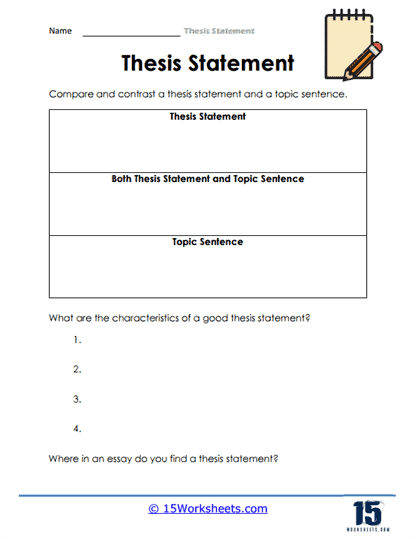
Compare And Contrast
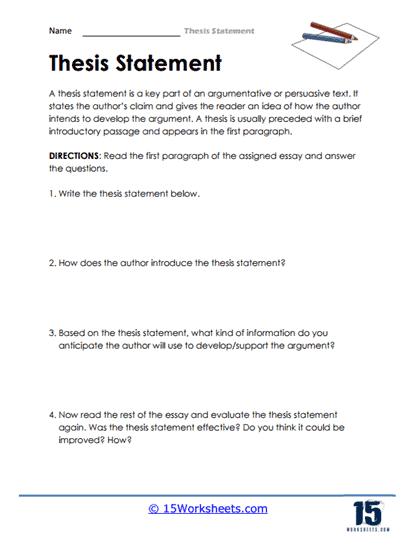
The First Paragraph
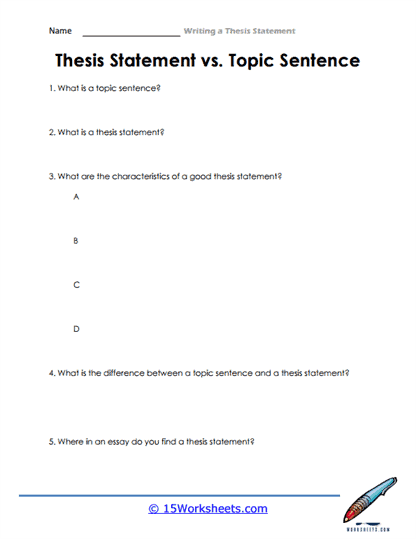
Statement Vs. Sentence
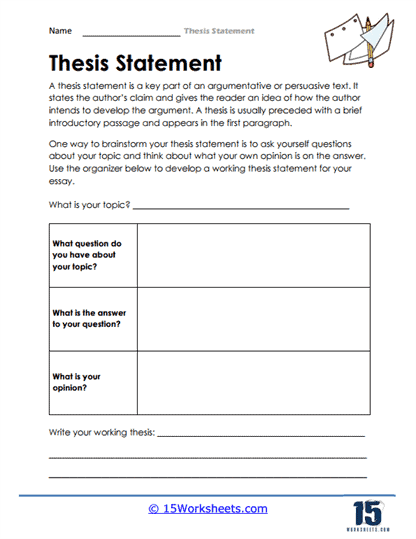
Brainstorming Process
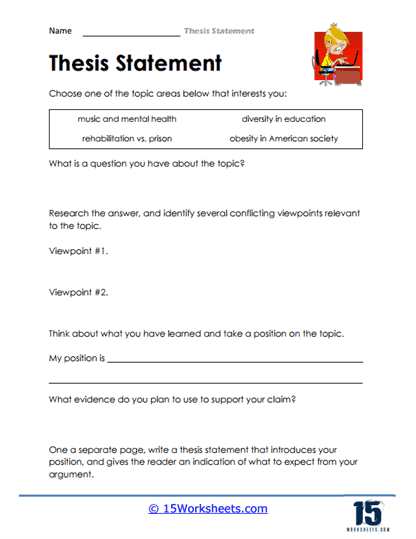
Interesting Topics
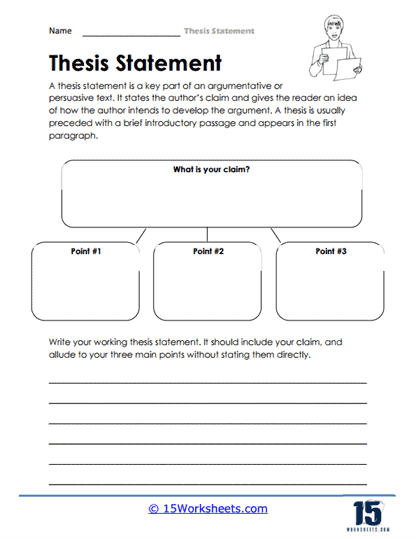
Claim And Points
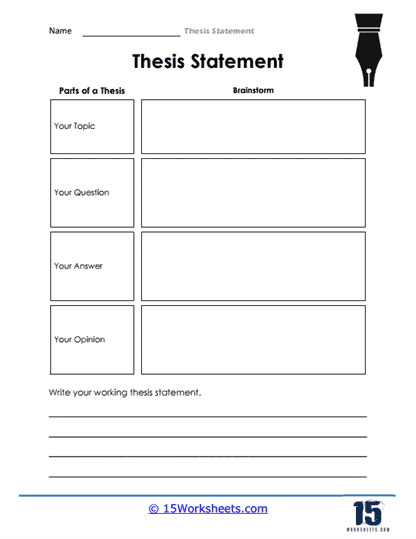
Breaking It Down
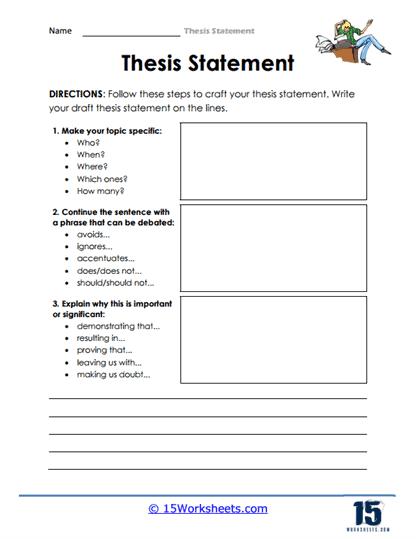
Follow The Steps
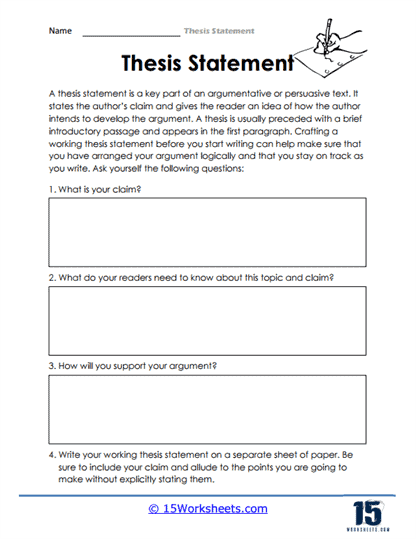
Craft The Key Part
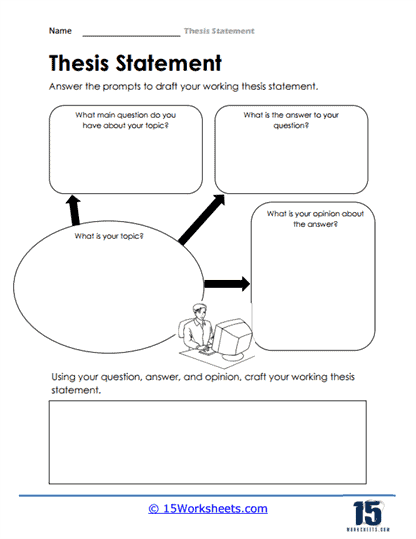
Answer The Prompts
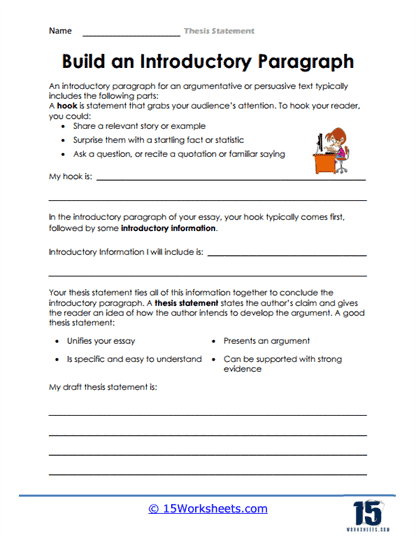
Build The Introductory
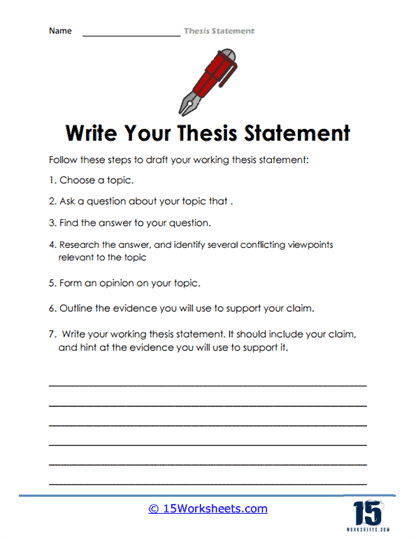
Step-By-Step Guide
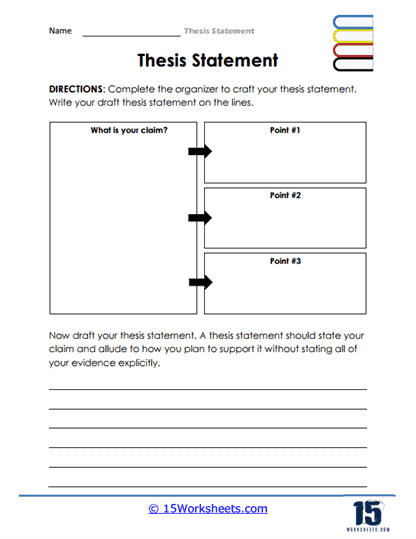
Complete The Organizer
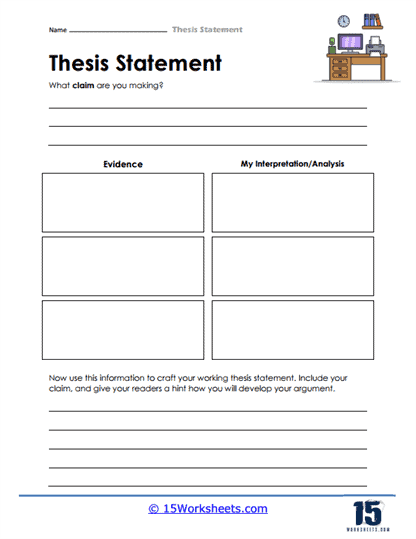
Your Interpretation
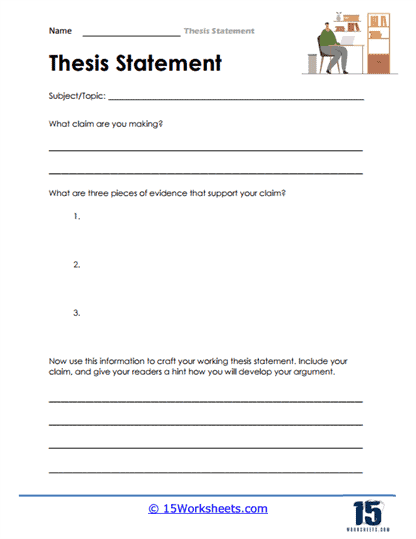
Give A Hint
All about these 15 worksheets.
This series of 15 worksheets offers an invaluable resource for students to master the art of creating compelling thesis statements. These meticulously designed worksheets provide step-by-step guidance to help students develop clear, focused, and persuasive thesis statements that form the backbone of their essays and arguments.
The varied writing prompts empower students to become proficient in articulating their main arguments concisely and effectively. Through a series of engaging exercises, students will learn the importance of a strong thesis statement in guiding their writing and influencing readers’ understanding and engagement. Through these worksheets, students will:
- Learn how a well-crafted thesis statement serves as a roadmap, guiding the organization and development of their essays;
- Learn the importance of clarity, specificity, and arguability in constructing effective thesis statements;
- Differentiate thesis statements from topic sentences;
- Refine their ability to express complex ideas in a clear and focused manner;
- And practice incorporating strong thesis statements into their essays, arguments, and persuasive pieces.
This series equips students with the skills necessary to craft compelling and influential thesis statements. By mastering the art of thesis statement writing, they enhance their critical thinking, persuasive writing, and organization skills, setting a strong foundation for their academic and professional endeavors.
Whether used in language arts classrooms, essay writing workshops, or as part of independent study, these Thesis Statements worksheets provide an invaluable resource for students to become proficient in developing clear, focused, and persuasive thesis statements.
How To Write A Thesis Statement
A thesis statement is very important for an essay. It summarizes your point or opinion on the subject in a single line. A thesis statement should be clear, concise, and strong, as all points in the essay will need to relate to it. Without a thesis statement, your essay will fall flat and lack information crucial to hook the reader. The thesis statement is also added at the end of the introduction and is a must-have if you want to persuade your reader.
Brainstorm Your Topic
The first step in writing a thesis statement is brainstorming. This step could vary depending on if the topic was already provided or not and the type of essay. Once the topic has been decided, ask questions, such as:
- Why are you choosing this topic?
- Is there relevant information available on the internet?
- Can you target the topic to a particular audience?
At this point, your topic is just a title and not a statement. The more questions you ask, the more specified and coherent your thesis statement will be.
Take Your Stance
After finalizing the topic, pick your stance on it. What’s your opinion about the topic? Do you oppose the idea or support it? You can provide a tentative answer over here and research to solidify your position on the subject.
Provide Supporting Ideas
Whether you support or oppose the subject, you need to research and mention key points here. Give your reasons with facts and figures about why you support/oppose this subject. It’s best to provide 3 to 4 supporting ideas to persuade the audience.
Include an Opposing Viewpoint
This is not a must-have in every thesis statement, but acknowledging the opposing point of view can significantly impact the statement. Adding counterarguments or issues that people might have with your statement will help both types of readers relate to the topic, thus, widening your reach.
Now that you know how to write a thesis statement, let’s look at the qualities of a good thesis statement and some examples.
Qualities of a Good Thesis Statement
Strong Stance
A good thesis statement includes a strong stance. You need to decide your position on the matter and stick to it throughout the essay. Also, try to be specific with your position and target a particular audience.
Encourages Discussion
Your thesis statement needs to encourage discussions. It can’t be a simple fact everyone knows and can’t disagree with. It should have to support opposing views so readers can change their minds.
One Main Idea
Your thesis statement should be clear and coherent. It needs to display one main idea. Even though there will be many supporting points and reasons throughout the essay, they should all link back to the main statement.
Examples of Good Thesis Statements
“Because many children are unable to vaccinate as a result of illness, all healthy and able children should be vaccinated to start the development of herd immunity.”
Libraries serve as essential resources for various communities. As such, they should have better funding from local municipalities.

- University of Pennsylvania
- School of Arts and Sciences
- Penn Calendar
Search form

Thesis and Introduction Worksheet
Katherine milligan.
Thesis Guidelines Your thesis should...
... make an argument regarding your topic
Tender Buttons
... consist of a strong statement
Sample Thesis Statements
There are many similarities and differences between Humbert Humbert and Clare Quilty.
Throughout history, men have written about lusting after women; Lolita is no exception.
Morality is not the issue in Lolita ; artistry is.
Lolita is a novel about America.
Lolita is a novel about the corruption of America.
In Lolita , the corruption of America merely provides a convenient cover-up for Humbert Humbert's personal perversion.
Lolita is an interesting novel, although the narrator, Humbert Humbert, is evil.
Love is dead in the twentieth century novel.
Although World War II is never mentioned in Lolita , its influence on American society motivates the novel.
Introduction Guidelines Your introduction should...
... lay the logical foundation for your paper.
... hook your reader. mandatory
Sample Introductions
There are many similarities and differences between the characters of Humbert Humbert and Clare Quilty. By examining these similarities and differences, several important ideas can be seen. Both characters are obsessive and paranoid, but Quilty is more successful than Humbert.
Throughout history, men have written about lusting after women. In the novel "Lolita" by Vladimir Nabokov, the main character is seduced by a nymphet, Dolores Haze. He has always been attracted to nymphets due to a traumatic experience with his first love, Annabel, when he was young himself. After Lolita's mother dies, he has her all to himself, and they take two trips across the country, staying in motels and sightseeing. In the end, he is deceived by Lolita, who runs away with Quilty and later gets pregnant and marries someone else. This demonstrates how love is always doomed to failure, since his possession of her was always an illusion.
In his essay "On a Book Entitled Lolita," Vladimir Nabokov writes that his novel has "no moral in tow" (314). Regardless of whether we agree with Nabokov, reducing Lolita to a discussion of moral issues misses the point. Lolita is a work of fiction and must be treated as such. The first few pages of the novel establish this point beyond the shadow of a doubt by alluding to such literary predecessors as Poe, Merimee, Dante, Proust, and Keats. Without understanding these allusions, the novel itself cannot be understood.
Is Lolita a love story? Answering this question in the affirmative requires a redefinition of the term "love." After all, Humbert Humbert causes more misery than joy to the object of his affections. Lolita's suffering, both mental and physical, is apparent throughout the novel. And yet Humbert's obsession with her goes beyond mere lust or passion. He is both tender and constant in his affections. As a close examination of the end of the novel will show, Humbert Humbert is a lover as well as a rapist.
- My Storyboards
Thesis Statement Worksheet Templates
Customize thesis statement templates.
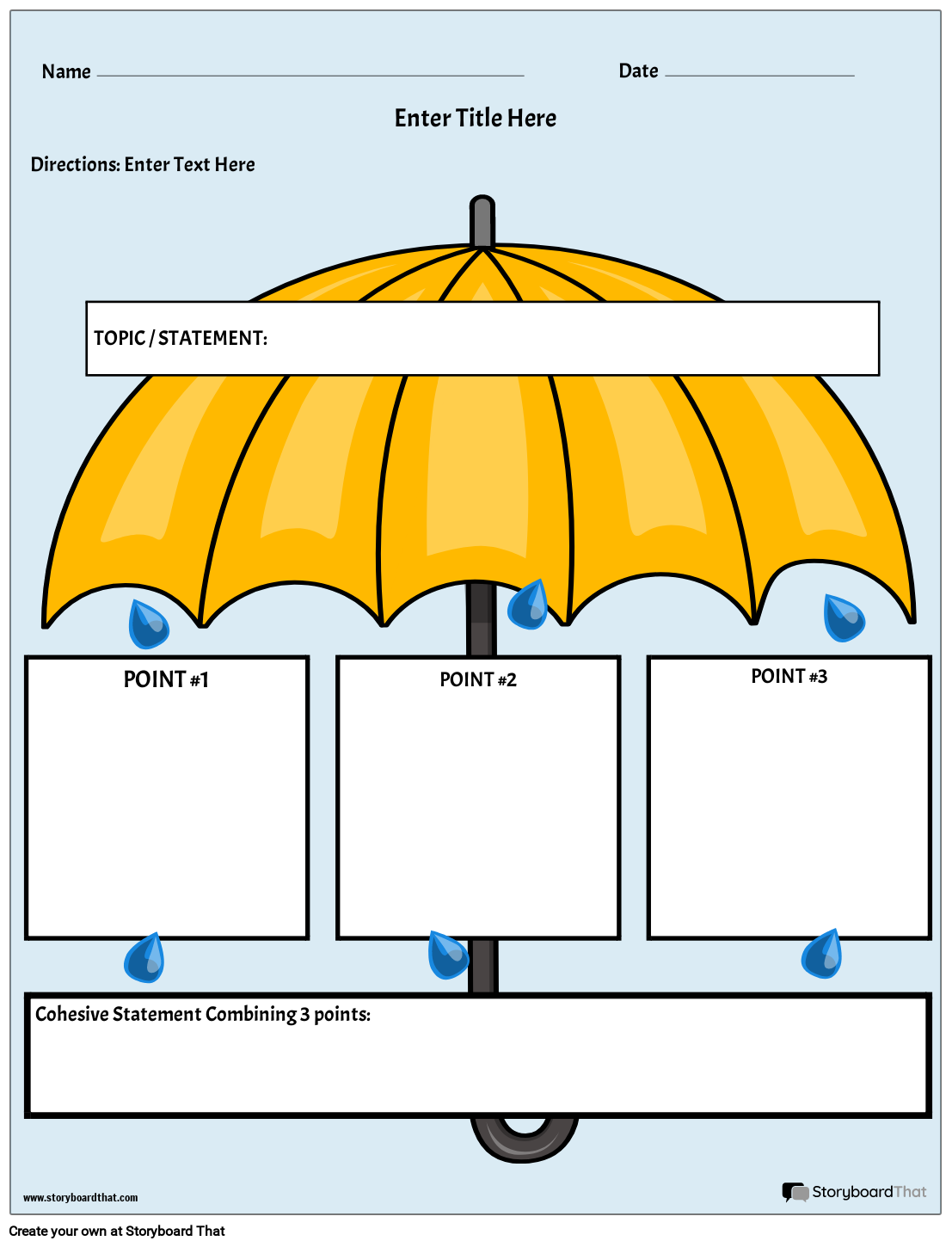
If you're assigning this to your students, copy the worksheet to your account and save. When creating an assignment, just select it as a template!

What is a Thesis Statement?
In academic writing, a thesis statement is the central idea, claim, or argument that guides the entire paper. Knowing how to write a one is essential for creating strong and coherent papers that convey your message effectively. However, crafting an effective statement is not easy and can be a daunting task for many writers, regardless of the subject. Our templates provide a structured framework for students to create well-crafted thesis statements that meet the requirements of academic writing.
What is a Thesis Statement Worksheet?
Our worksheets help plan for any essay or paper. Students can use a specific (enumerative) thesis statement or an umbrella thesis statement to plan out the primary idea of their essay and practice writing effective ideas. Academic writing often requires a strong statement that sets the tone and purpose of the work.
Why Are These Graphic Organizers Important and How Are They Best Used?
Thesis statements are the bedrock for any paper, debate, or other writing assignment. It is used to guide the writing and keep ideas focused on proving that statement true with relevant evidence. Students often have a difficult time getting started, so these templates can help guide them as they craft one to guide their writing. By using a template, learners can structure their thoughts and ideas to create something that is clear, concise, and effective. Outlines provide a framework for writers to understand the different types, generate ideas, and effectively communicate their message. Additionally, graphic organizers offer a visual way to organize ideas, making the process of writing more accessible for learners.
There are different types of worksheets that are designed for different purposes and levels of writing proficiency. Some worksheets may be geared towards helping students develop a basic understanding of how to get started, while others may be more advanced and focused on refining and strengthening existing pieces of writing. Having different templates gives students a choice on which is most useful for their task.

Other Useful Tips for Creating Successful/Useful Thesis Statements Organizer Worksheets
Using worksheet templates can be a powerful tool for helping kids craft strong and effective writing. By providing a structured framework for organizing ideas, learners can better understand the key elements and how to write one effectively. A graphic organizer example can help learners understand the different categories, such as argumentative, analytical, or expository, and how to write a something that fits within these categories.
Graphic organizer examples offer visual representations for parts such as the topic, argument, and main points. This approach can be particularly useful for visual learners who may struggle with written instructions. Templates also allow for differentiation of instruction for learners with different skill levels. For example, some templates may be more structured for learners who are just beginning to learn this type of writing, while others may allow for more flexibility and creativity for more advanced learners.
Using a template can also help learners to better understand the purpose of what they are writing. By breaking down the different components, learners have the space to see how their thesis statement relates to the broader context of their paper and how it guides the reader towards their argument or main point. Overall, worksheet templates can be an effective way to support learners with different learning styles and skill levels and help them to master the art of writing a strong and effective thesis statement.
How to Make A Good Thesis Statement
While a worksheet can be a helpful tool for developing your writing skills, it is not a substitute for careful reading, research, and critical thinking. When using a planning worksheet, it is important to carefully read and follow the instructions and prompts provided. Pay attention to the specific requirements of the assignment, such as the length and format of the thesis statement, as well as the audience and purpose of the writing. Be prepared to revise and refine as needed, based on feedback from your instructor or other readers.
Planning templates are effective by guiding writers through a series of prompts or questions that help them develop a clear and focused argument for their writing assignment. Typically, the worksheet will begin by asking the student to identify the topic of their paper and narrow it down to a specific focus.
The prompts may then ask the student to consider different aspects of their argument, such as the key points they want to make, the evidence they will use to support their claims, and the counterarguments or objections they may need to address. Some worksheets may also provide examples and offer tips for crafting a strong and persuasive argument.
As the student works through the prompts, they will begin to develop a more refined and focused statement that effectively communicates the main argument of their paper. They may also receive feedback or suggestions for improvement from their instructor or peers, which they can use to revise and refine further.
Graphic Organizer Worksheets
Tips to consider when making your worksheet:
- Define the purpose and goals of the worksheet. Determine what specific skills or concepts you want your students to develop and what types of writing assignments they will be working on.
- Choose appropriate prompts or questions. Develop a series of prompts or questions that guide learners through the process of developing a clear and focused thesis statement. The prompts should be clear, concise, and relevant to the specific writing assignment.
- Provide examples and feedback. Offer examples and provide feedback and suggestions for improvement to help students refine their writing skills.
- Consider the needs of different learners. Be sure to consider the needs of different types of learners, such as visual, auditory, and kinesthetic learners, and include a variety of activities and strategies to engage all learners.
- Test and revise the worksheet. Try out the worksheet with a small group and gather feedback to identify any areas that may need to be revised or clarified.
- Provide instruction and support. Introduce the worksheet to your class and provide clear instructions and support as they work through the prompts and activities.
- Monitor progress and provide feedback. Monitor progress and provide ongoing feedback and support to help develop writing skills.
Free Thesis Statement Worksheets With Storyboard That
Storyboard That is not just a classroom label maker, it's also a versatile tool that can be used as a thesis statement generator free or even to create various educational resources. With the thesis statement maker, you can easily create templates that guide students in crafting strong and clear thesis statements. Simply choose a template and click on the elements to customize them according to your needs. Once done, you can save the worksheet and either print it right away or keep it in your storyboard library for later use. Whether you need to create free thesis statement worksheets, a specific type of thesis statement, or a general guide to writing thesis statements, Storyboard That's thesis statement creator can help simplify the process and provide a clear and structured framework for kids to follow.
How to Make a Thesis Statement Worksheet
Choose one of the premade templates.
We have lots of templates to choose from. Take a look at our example for inspiration!
Click on "Copy Template"
Once you do this, you will be directed to the storyboard creator.
Give Your Worksheet a Name!
Be sure to call it something related to the topic so that you can easily find it in the future.
Edit Your Worksheet
This is where you will include directions, specific questions and images, and make any aesthetic changes that you would like. The options are endless!
Click "Save and Exit"
When you are finished with your worksheet, click this button in the lower right hand corner to exit your storyboard.
From here you can print, download as a PDF, attach it to an assignment and use it digitally, and more!
Related Storyboard That Resources and Printables
- Essay Outline Worksheets
- Long Composition Template
- Outline Template Worksheets
- Sequencing Worksheets
Happy Creating!
Frequently Asked Questions about Thesis Statements
Do i need a worksheet to figure out how to write a thesis statement.
While you don't necessarily need a worksheet to write a thesis statement, a worksheet can help you organize your thoughts and ensure that your thesis statement is strong and effective. Worksheets can provide prompts, examples, and feedback to guide you through the process of how to create a thesis statement that works. They can also help students to work through various examples of both strong and weak thesis statements, and help develop their ability to recognize the characteristics of effective thesis statements, such as clarity, specificity, and a clear argumentative focus. Additionally, the exercises facilitated by the worksheets can help students understand how to develop a thesis statement that effectively guides their writing and provides a strong foundation for their argument. Through the use of example exercises worksheets, students can improve their critical thinking skills and gain confidence in their ability to craft a strong thesis statement.
What is an umbrella thesis statement?
An umbrella thesis statement is a broad statement that encompasses the main point of a paper without providing specific details or evidence. It is called an "umbrella" because it covers a large topic or issue that can be broken down into smaller subtopics for further exploration. An example of an umbrella thesis statement is "The impact of technology on society." Umbrella thesis examples can be an effective tool for teaching students about the importance of clarity and specificity in thesis statements. By using umbrella thesis examples, students can see how a broad topic can be narrowed down into a specific statement that provides a clear direction for the paper. This can help students understand how to craft a thesis statement that is both focused and specific, while still allowing for flexibility in their argument.
How do the worksheets help me to figure out how to make a thesis statement?
Thesis statement exercises worksheets are meant to help students to organize their thoughts and ideas before they begin to write a thesis statement. Worksheets help by providing clear and concise prompts, examples, and support, and helps students to understand the key components of a strong thesis statement and to develop their own unique ideas and arguments. Through the use of a worksheet, students are able to refine their ideas and ensure that their thesis statement accurately reflects the content of their essay or research paper. Ultimately, the worksheet serves as a valuable guide that helps students to write a clear and effective thesis statement.
Try 1 Month For
30 Day Money Back Guarantee New Customers Only Full Price After Introductory Offer
Learn more about our Department, School, and District packages

- Thousands of images
- Custom layouts, scenes, characters
- And so much more!!
Create a Storyboard

- school Campus Bookshelves
- menu_book Bookshelves
- perm_media Learning Objects
- login Login
- how_to_reg Request Instructor Account
- hub Instructor Commons
Margin Size
- Download Page (PDF)
- Download Full Book (PDF)
- Periodic Table
- Physics Constants
- Scientific Calculator
- Reference & Cite
- Tools expand_more
- Readability
selected template will load here
This action is not available.

5.2: Identifying Thesis Statements and Topic Sentences
- Last updated
- Save as PDF
- Page ID 25748
\( \newcommand{\vecs}[1]{\overset { \scriptstyle \rightharpoonup} {\mathbf{#1}} } \)
\( \newcommand{\vecd}[1]{\overset{-\!-\!\rightharpoonup}{\vphantom{a}\smash {#1}}} \)
\( \newcommand{\id}{\mathrm{id}}\) \( \newcommand{\Span}{\mathrm{span}}\)
( \newcommand{\kernel}{\mathrm{null}\,}\) \( \newcommand{\range}{\mathrm{range}\,}\)
\( \newcommand{\RealPart}{\mathrm{Re}}\) \( \newcommand{\ImaginaryPart}{\mathrm{Im}}\)
\( \newcommand{\Argument}{\mathrm{Arg}}\) \( \newcommand{\norm}[1]{\| #1 \|}\)
\( \newcommand{\inner}[2]{\langle #1, #2 \rangle}\)
\( \newcommand{\Span}{\mathrm{span}}\)
\( \newcommand{\id}{\mathrm{id}}\)
\( \newcommand{\kernel}{\mathrm{null}\,}\)
\( \newcommand{\range}{\mathrm{range}\,}\)
\( \newcommand{\RealPart}{\mathrm{Re}}\)
\( \newcommand{\ImaginaryPart}{\mathrm{Im}}\)
\( \newcommand{\Argument}{\mathrm{Arg}}\)
\( \newcommand{\norm}[1]{\| #1 \|}\)
\( \newcommand{\Span}{\mathrm{span}}\) \( \newcommand{\AA}{\unicode[.8,0]{x212B}}\)
\( \newcommand{\vectorA}[1]{\vec{#1}} % arrow\)
\( \newcommand{\vectorAt}[1]{\vec{\text{#1}}} % arrow\)
\( \newcommand{\vectorB}[1]{\overset { \scriptstyle \rightharpoonup} {\mathbf{#1}} } \)
\( \newcommand{\vectorC}[1]{\textbf{#1}} \)
\( \newcommand{\vectorD}[1]{\overrightarrow{#1}} \)
\( \newcommand{\vectorDt}[1]{\overrightarrow{\text{#1}}} \)
\( \newcommand{\vectE}[1]{\overset{-\!-\!\rightharpoonup}{\vphantom{a}\smash{\mathbf {#1}}}} \)
Being able to identify the purpose and thesis of a text, as you’re reading it, takes practice. This section will offer you that practice.
One fun strategy for developing a deeper understanding the material you’re reading is to make a visual “map” of the ideas. Mind maps, whether hand-drawn or done through computer programs, can be fun to make, and help put all the ideas of an essay you’re reading in one easy-to-read format.
Your understanding of what the “central” element of the mind map is might change as you read and re-read. Developing the central idea of your mind map is a great way to help you determine the reading’s thesis.

Figure 2.5. 1
- Hand-drawn Mind Map
Locating Explicit and Implicit Thesis Statements
In academic writing, the thesis is often explicit : it is included as a sentence as part of the text. It might be near the beginning of the work, but not always–some types of academic writing leave the thesis until the conclusion.
Journalism and reporting also rely on explicit thesis statements that appear very early in the piece–the first paragraph or even the first sentence.
Works of literature, on the other hand, usually do not contain a specific sentence that sums up the core concept of the writing. However, readers should finish the piece with a good understanding of what the work was trying to convey. This is what’s called an implicit thesis statement: the primary point of the reading is conveyed indirectly, in multiple locations throughout the work. (In literature, this is also referred to as the theme of the work.)
Academic writing sometimes relies on implicit thesis statements, as well.
This video offers excellent guidance in identifying the thesis statement of a work, no matter if it’s explicit or implicit.
Topic Sentences
We’ve learned that a thesis statement conveys the primary message of an entire piece of text. Now, let’s look at the next level of important sentences in a piece of text: topic sentences in each paragraph.
A useful metaphor would be to think of the thesis statement of a text as a general: it controls all the major decisions of the writing. There is only one thesis statement in a text. Topic sentences, in this relationship, serve as captains: they organize and sub-divide the overall goals of a writing into individual components. Each paragraph will have a topic sentence.

Figure 2.5. 2
It might be helpful to think of a topic sentence as working in two directions simultaneously. It relates the paragraph to the essay’s thesis, and thereby acts as a signpost for the argument of the paper as a whole, but it also defines the scope of the paragraph itself. For example, consider the following topic sentence:
Many characters in Lorraine Hansberry’s play A Raisin in the Sun have one particular dream in which they are following, though the character Walter pursues his most aggressively.
If this sentence controls the paragraph that follows, then all sentences in the paragraph must relate in some way to Walter and the pursuit of his dream.
Topic sentences often act like tiny thesis statements. Like a thesis statement, a topic sentence makes a claim of some sort. As the thesis statement is the unifying force in the essay, so the topic sentence must be the unifying force in the paragraph. Further, as is the case with the thesis statement, when the topic sentence makes a claim, the paragraph which follows must expand, describe, or prove it in some way. Topic sentences make a point and give reasons or examples to support it.
The following diagram illustrates how a topic sentence can provide more focus to the general topic at hand.
Placement of Topic Sentences
What if I told you that the topic sentence doesn’t necessarily need to be at the beginning? This might be contrary to what you’ve learned in previous English or writing classes, and that’s okay. Certainly, when authors announce a topic clearly and early on in a paragraph, their readers are likely to grasp their idea and to make the connections that they want them to make.
However, when authors are writing for a more sophisticated academic audience—that is an audience of college-educated readers—they will often use more sophisticated organizational strategies to build and reveal ideas in their writing. One way to think about a topic sentence, is that it presents the broadest view of what authors want their readers to understand. This is to say that they’re providing a broad statement that either announces or brings into focus the purpose or the meaning for the details of the paragraph. If the topic sentence is seen as the broadest view, then every supporting detail will bring a narrower—or more specific—view of the same topic.
With this in mind, take some time to contemplate the diagrams in the figure below. The widest point of each diagram (the bases of the triangles) represents the topic sentence of the paragraph. As details are presented, the topic becomes narrower and more focused. The topic can precede the details, it can follow them, it can both precede and follow them, or the details can surround the topic. There are surely more alternatives than those that are presented here, but this gives you an idea of some of the possible paragraph structures and possible placements for the topic sentence of a paragraph.
Consider some of the following examples of different topic sentence placements in a paragraph from a review essay of the beloved children’s book, The Cat in the Hat , by Dr. Seuss. Paragraph structures are labeled according to the diagrams presented above, and topic sentences are identified by red text.
Topic Sentence-Details-Topic Sentence
A good children’s book requires an exciting plot and a problem with which children can sympathize. In The Cat in the Hat there is plenty of action, depicted in the wild antics of the cat, and later in the amazing but dangerous and messy tricks of Thing 1 and Thing 2. All this excitement and action naturally draws children into the story and keeps the plot moving forward at a pace that maintains their interest. There is also tension to be resolved. The fish senses danger and constantly warns the children not to participate in the cat’s perilous stunts. And later, as the mother’s return becomes more imminent, the children begin to heed the fish’s warning and finally wish to contain the chaos and clean up the mess, but how? While this plot is fantastic enough to fuel any child’s imagination, it also contains a problem with which any child can relate: a mess and the threat of a parent’s disapproval. The careful balance of action, tension, and relatability is what makes this book an enduring childhood favorite.
Topic Sentence-Details
The careful balance of action, tension, and relatability is what makes Dr. Seuss’s The Cat in the Hat an enduring childhood favorite. In The Cat in the Hat there is plenty of action, depicted in the wild antics of the cat, and later in the amazing but dangerous and messy tricks of Thing 1 and Thing 2. All this excitement and action naturally draws children into the story and keeps the plot moving forward at a pace that maintains their interest. There is also tension to be resolved. The fish senses danger and constantly warns the children not to participate in the cat’s perilous stunts. And later, as the mother’s return becomes more imminent, the children begin to heed the fish’s warning and finally wish to contain the chaos and clean up the mess, but how? While this plot is fantastic enough to fuel any child’s imagination, it also contains a problem with which any child can relate: a mess and the threat of a parent’s disapproval.
You can relocate the topic sentence to the end here, and you’ll have an example of the Details-Topic Sentence method of organizing the paragraph.
Details-Topic Sentence-Details
In The Cat in the Hat there is plenty of action, depicted in the wild antics of the cat, and later in the amazing but dangerous and messy tricks of Thing 1 and Thing 2. All this excitement and action naturally draws children into the story and keeps the plot moving forward at a pace that maintains their interest. The careful balance of action, tension, and relatability is what makes Dr. Seuss’s The Cat in the Hat an enduring childhood favorite. There is definitely tension to be resolved here. The fish senses danger and constantly warns the children not to participate in the cat’s perilous stunts. And later, as the mother’s return becomes more imminent, the children begin to heed the fish’s warning and finally wish to contain the chaos and clean up the mess, but how? While this plot is fantastic enough to fuel any child’s imagination, it also contains a problem with which any child can relate: a mess and the threat of a parent’s disapproval.
Explicit and Implicit Topic Sentences
Similar to thesis statements, topic sentences may be explicit or implicit.
Consider the following paragraph from an essay titled “The Bothersome Beauty of Pigeons,” by author and Boise State writing professor, Bruce Ballenger. It’s important to note that this is a personal narrative essay rather than a more traditional academic essay, but the paragraph provides a good example of an implied topic. In this essay Ballenger takes the time to consider the beauty of pigeons, a bird that’s usually thought of as nothing more than a nuisance. Just prior to this paragraph, Ballenger talks about how he used a fake owl to scare away pigeons on his property. He goes on to explain,
My pigeons moved next door where an elderly couple feed them bird seed and have the time and willingness to clean up after their new charges; so it seems, in this case, things have worked out for everyone. But the large flocks still haunt the piazzas in Florence and Venice, the squares in London, and similar places in nearly every city across the globe. Despite their ability to distinguish between a Van Gogh and a Chagall, pigeons still deposit droppings that deface the great marble statues and facades–the works of art and architecture that are part of our human heritage–and yet people still buy bags of seed for about a dollar and pose for photographs, drenched in doves. Meanwhile, officials in these cities continue, sometimes quietly, to wage war against the birds (“Introduction”).
Here, Ballenger seems to be saying that in spite of the attempts of so many to rid themselves of the pigeons, others are still drawn to them and will feed them and encourage them to come back. His main idea seems to be that the battle against pigeons is a losing proposition, but he doesn’t come out and say so. His message in this paragraph is implied. Do you think this paragraph would be improved with an explicit topic sentence?
EXERCISE 1: Identify the Topic and Focus
Choose a piece of writing, perhaps an essay or some news articles found online, and for each paragraph identify (1) the topic and (2) the more focused idea. Remember, the topic sentence applies more focus to the broader topic to help narrow the scope of the paragraph. For example, the topic of a paragraph might be school lunches. The more focused idea of that same paragraph might be the idea of having students plant school gardens as a way to help incorporate more fresh produce in the menu.
License and Attributions:
CC licensed content, Previously shared:
Basic Reading and Writing. Authored by: Lumen. Located at: https://human.libretexts.org/Bookshelves/Composition/Book:_Basic_Reading_and_Writing_(Lumen)/ Module_2:_Critical_Reading/2.05:_Identifying_Thesis_Statements License: CC BY: Attribution.
Adaptions: Reformatted, some content removed to fit a broader audience.
Module 2: Critical Reading
Identifying thesis statements, introduction, learning objectives.
- identify explicit thesis statements in texts
- identify implicit thesis statements in texts
- identify strategies for using thesis statements to predict content of texts
Being able to identify the purpose and thesis of a text, as you’re reading it, takes practice. This section will offer you that practice.
One fun strategy for developing a deeper understanding the material you’re reading is to make a visual “map” of the ideas. Mind maps, whether hand-drawn or done through computer programs, can be fun to make, and help put all the ideas of an essay you’re reading in one easy-to-read format.
Your understanding of what the “central” element of the mind map is might change as you read and re-read. Developing the central idea of your mind map is a great way to help you determine the reading’s thesis.

Hand-drawn Mind Map
Locating Explicit and Implicit Thesis Statements
In academic writing, the thesis is often explicit : it is included as a sentence as part of the text. It might be near the beginning of the work, but not always–some types of academic writing leave the thesis until the conclusion.
Journalism and reporting also rely on explicit thesis statements that appear very early in the piece–the first paragraph or even the first sentence.
Works of literature, on the other hand, usually do not contain a specific sentence that sums up the core concept of the writing. However, readers should finish the piece with a good understanding of what the work was trying to convey. This is what’s called an implicit thesis statement: the primary point of the reading is conveyed indirectly, in multiple locations throughout the work. (In literature, this is also referred to as the theme of the work.)
Academic writing sometimes relies on implicit thesis statements, as well.
This video offers excellent guidance in identifying the thesis statement of a work, no matter if it’s explicit or implicit.
Topic Sentences
We’ve learned that a thesis statement conveys the primary message of an entire piece of text. Now, let’s look at the next level of important sentences in a piece of text: topic sentences in each paragraph.
A useful metaphor would be to think of the thesis statement of a text as a general: it controls all the major decisions of the writing. There is only one thesis statement in a text. Topic sentences, in this relationship, serve as captains: they organize and sub-divide the overall goals of a writing into individual components. Each paragraph will have a topic sentence.

It might be helpful to think of a topic sentence as working in two directions simultaneously. It relates the paragraph to the essay’s thesis, and thereby acts as a signpost for the argument of the paper as a whole, but it also defines the scope of the paragraph itself. For example, consider the following topic sentence:
Many characters in Lorraine Hansberry’s play A Raisin in the Sun have one particular dream in which they are following, though the character Walter pursues his most aggressively.
If this sentence controls the paragraph that follows, then all sentences in the paragraph must relate in some way to Walter and the pursuit of his dream.
Topic sentences often act like tiny thesis statements. Like a thesis statement, a topic sentence makes a claim of some sort. As the thesis statement is the unifying force in the essay, so the topic sentence must be the unifying force in the paragraph. Further, as is the case with the thesis statement, when the topic sentence makes a claim, the paragraph which follows must expand, describe, or prove it in some way. Topic sentences make a point and give reasons or examples to support it.
The topic sentence is often, though not always, the first sentence of a paragraph.
- Outcome: Thesis. Provided by : Lumen Learning. License : CC BY: Attribution
- Revision and Adaptation of Topic Sentences. Provided by : Lumen Learning. License : CC BY: Attribution
- Image of hand-drawn mind map. Authored by : Aranya. Located at : https://commons.wikimedia.org/wiki/File:Guru_Mindmap.jpg . License : CC BY-SA: Attribution-ShareAlike
- Topic Sentences. Authored by : Ms. Beardslee. Located at : http://msbeardslee.wikispaces.com/Topic+Sentences?showComments=1 . License : CC BY-SA: Attribution-ShareAlike
- Image of Parts of a Paragraph. Authored by : Enokson. Located at : https://flic.kr/p/ak9H3v . License : CC BY: Attribution
- How to Identify the Thesis Statement. Authored by : Martha Ann Kennedy. Located at : https://youtu.be/di1cQgc1akg . License : All Rights Reserved . License Terms : Standard YouTube License
- Grade Levels
- Search Site
- Grade 9-10 >>
Thesis Statement Worksheets
Related ela standard: w.9-10.1.
The thesis statement of a paper is the line that expresses the main objective of the work. They are difficult to nail down for most writers. For a thesis statement to be considered strong, it must be detailed and cover all the aspects of the argument to be made. Writers need to explore the good, the bad, and everything in between. These worksheets will help you become a better thesis statement writer. Just work your way through this awesome collection of writing worksheets to get the most out of it.
Thesis Statement Worksheets:
The Thesis Sentence - Vaccinations, which are critical to the control and eradication of deadly infections diseases, should be mandatory, without exception, for every student in the U.S. who wants to attend school.
Writing Arguments: Blending Fact and Opinion - Choose one of your opinion sentences above to develop into an argumentative essay. This is the key to posing a well developed thesis statement.
Writing Leads. - In order to increase academic performance and curtail disruptive behavior, all U.S. school should require students to wear uniforms.
Let's Get Legal - Research the issues surrounding existing or proposed laws about the topic broadly enough to identify several conflicting viewpoints.
Supporting a Claim - If you are writing to try to convince or persuade others to believe a certain thing or to take some particular action, then you are writing a argumentative or persuasive paragraph.
Writing about Social Issues - If there's one thing you can be certain of, there is never only one side to a social issue. Learn how to propose a thesis in uncertain conditions.
Take a Moral Stand - Research the issues surrounding existing the topic broadly enough to identify several conflicting viewpoints. Think about what you have learned, and then take a position on the topic.
Introducing a Claim - Choose one of the topic areas below. Research the issues surrounding existing the topic broadly enough to identify several conflicting viewpoints.
Writing Arguments that Support Claims - What are you trying to convince the reader of? This provides you with space to walk through this in your mind.
Elective Classes - What elective classes does your school offer? Do you feel your school offers a diverse enough choice of electives?
Position Statements - Should high school students be allowed to date? What age is the best age to begin dating? Why?
Writing Thesis Sentences - A thesis sentence is the main topic sentence of an essay. It states the argument in a piece of persuasive writing, and often gives an indication what the main sections of the essay will be, and how the argument will unfold.
Supporting Claims: The Media - People are constantly debating the current state of the media, which has changed dramatically in the last several decades.
The Editorial - Editorial essays express the author's feelings about a subject. The thesis sentence should be supported with reasons and evidence.
Family Issues: Make a Claim - Many controversial issues are specific to the family. Do you have a strong opinion about any of them?
Using Evidence In Your Thesis Statements
Evidence is a fact, a source or any other data used to support a claim. It can be the data extracted from an experiment or by a research project. Writing an argument that offer a sense of support to your undeniable information is very important. Arguments must be written in a style that helps convince or persuade the reader to accept the writer's statement of facts or point of view rather than making them feel guilty to have an opposite point of view.
Given below are some tips that will help one to write arguments to support evidence:
Posing It Correctly
If we question someone about some topic and their answer addresses a completely different topic, it is natural for us to get irritated. Similarly, arguing about unrelated facts or data will annoy the reader. Before writing the arguments, understand the evidence and be sure to position the way it is presented correctly.
Supporting Your Argument with Valid Reasons
An invalid argument will be of no use therefore, you must support your evidence with the help of proven statics, charts, or other facts and figures along with their references. This will help to make your argument strong and the reader will be convinced to accept your evidence.
Write arguments clearly but concisely. A long section of arguments will irritate the readers and they will decide not to read it at all. Make sure only to add useful information in arguments. Write your arguments to support evidence in easy and simple language and keep your arguments as brief as possible.
Use Expert Opinion
Expert opinions are the factual interpretations of some data or information. Ask for some expert opinion about your evidence and quote it in the arguments section to convince the reader to agree with your evidence.
Imagine Yourself as The Reader
While reading your evidence and arguments, imagine yourself as the reader. Try not to accept your presentation of the facts and disagree with your arguments. Then write the arguments so validly that will convince you as a reader to accept the evidence you have given.
Teachers: Upgrade Now
- Print all 25,000+ worksheets
- All grade levels and topics
- Save endless hours of your time...
- Answers to everything too!
Get FREE English Worksheets In Your Email
- How We Are Aligned To The Common Core
- Educator Resources
- Privacy Policy
- Newsletters
© English Worksheets Land . All rights reserved.

IMAGES
VIDEO
COMMENTS
Thesis Statement Worksheet A thesis statement is a sentence that tells your reader your topic, what you think about it, and possibly how you are going to prove it. Create a research question based on your class assignment. Start to read about your topic to generate more ideas for your research and writing. Collect facts from articles.
Thesis Activity. One way to think about a thesis statement is: An effective thesis is one that is not obvious; rather it is one that is discussible, arguable, and interesting. Avoid self-evident statements. In the US, movie stars are greatly admired. A strong thesis will give readers an idea of the general direction of your paper and the ...
Thesis statement: *. 3. Passion and willingness to work hard can only offer a prospective employer so much. Unless you can show how your experiences have helped prepare you for the position you are interviewing for, the employers may decide to go with a candidate who has completed the appropriate training already.
5. A troublesome thesis is a fragment; a good thesis statement is expressed in a complete sentence. Example: How life is in New York after September 11th. Better: After September 11th, the city of New York tends to have more cases of post-traumatic disorder than other areas of the United States and rightfully so.
About this Worksheet: Practice developing thesis statements with this writing introduction worksheet! Students will learn how to improve their writing with a strong, attention grabbing thesis statement. This activity helps build writing skills by asking students to create a statement for the topics provided, such as: "What was the greatest ...
Through its contrasting river and shore scenes, Twain's Huckleberry Finn suggests that to find the true expression of American democratic ideals, one must leave "civilized" society and go back to nature. This final thesis statement presents an interpretation of a literary work based on an analysis of its content.
Step 3: Writing a Thesis Statement This worksheet will help you draft a solid thesis statement. Remember, the thesis holds your paper together and guides your research, so be sure it says exactly what you mean. The spaces below are provided for you to write notes; you may also use additional paper.
Thesis statements - 1-2 sentences that tell the reader your topic and what you will say about it. Direct thesis statements outline the main idea and the organization of the essay for the reader. Underline the topic, circle the controlling idea, and double underline the sub-topics in the following
Step 1: Start with a question. You should come up with an initial thesis, sometimes called a working thesis, early in the writing process. As soon as you've decided on your essay topic, you need to work out what you want to say about it—a clear thesis will give your essay direction and structure.
A thesis statement: tells the reader how you will interpret the significance of the subject matter under discussion. is a road map for the paper; in other words, it tells the reader what to expect from the rest of the paper. directly answers the question asked of you. A thesis is an interpretation of a question or subject, not the subject itself.
Step 2) Brainstorm some possible answers to your question. Step 3) Combine your best answer(s) and your question into a thesis statement. Academic Writing Tools: To outline your essay see our Outline: Short Essay (fewer than 5 pages) or Extended Essay (+ 5 pages). If your instructor has requested an annotated bibliography, see Writing Guide ...
Thesis Statement: Student Worksheet. Purpose: To provide students with a tool to practice formulating and writing topic sentences and thesis statements.. The organizer displays the formula (setting, subject, big idea) and four boxes for planning ideas and recording fancy words. The lines below the boxes are for students to write these powerful ...
In the lower right corner of the activity, click the printer icon. (NOTE: This is not the Print button at the bottom of the page.) Select either Print all slides or Print current slide.On the Print popup, under Destination, click the Change… button. Select Save as PDF.In the Print popup, click the Save button In the Save As popup window, give the file a name.
Exercise Directions: Create a thesis statement based on the following information. Topic 1: Education is important to have. It could enable one to get a better paying job. It makes a person a more interesting individual. It makes a person a more informed citizen. Topic 2: Bowling is a sport for everyone.
Be ready to defend your choices. Because these thesis statements appear outside the context of complete essays, all responses are judgment calls, not absolute certainties. (a) The Hunger Games is a science fiction adventure film based on the novel of the same name by Suzanne Collins. (b) The Hunger Games is a morality tale about the dangers of ...
All About These 15 Worksheets. This series of 15 worksheets offers an invaluable resource for students to master the art of creating compelling thesis statements. These meticulously designed worksheets provide step-by-step guidance to help students develop clear, focused, and persuasive thesis statements that form the backbone of their essays ...
Have a thesis. -write succinctly and specifically. Say what your argument is and what steps you're going to take to prove it. optional. -use a key quotation. This does not have to be from the text on which you are writing. Cite it, unpack it, explain why it is relevant, and use it to formulate your thesis.
Writing a Thesis Statement (Lesson 21 - Practice Worksheet B) Directions: Read each outline for a composition. Then write an appropriate thesis statement on the lines for the composition described. 1. a composition that discusses the responsibilities involved in caring for a pet. Topic: What pet ownership involves. A.
identify strategies for using thesis statements to predict content of texts. Being able to identify the purpose and thesis of a text, as you're reading it, takes practice. This section will offer you that practice. One fun strategy for developing a deeper understanding the material you're reading is to make a visual "map" of the ideas.
Our worksheets help plan for any essay or paper. Students can use a specific (enumerative) thesis statement or an umbrella thesis statement to plan out the primary idea of their essay and practice writing effective ideas. Academic writing often requires a strong statement that sets the tone and purpose of the work.
Adaptions: Reformatted, some content removed to fit a broader audience. 5.2: Identifying Thesis Statements and Topic Sentences is shared under a CC BY-NC-ND license and was authored, remixed, and/or curated by LibreTexts. Topic sentences and thesis statements are similar to main ideas. This section discusses those similarities and the ...
identify strategies for using thesis statements to predict content of texts. Being able to identify the purpose and thesis of a text, as you're reading it, takes practice. This section will offer you that practice. One fun strategy for developing a deeper understanding the material you're reading is to make a visual "map" of the ideas.
For a thesis statement to be considered strong, it must be detailed and cover all the aspects of the argument to be made. Writers need to explore the good, the bad, and everything in between. These worksheets will help you become a better thesis statement writer. Just work your way through this awesome collection of writing worksheets to get ...
However, you can try the following workaround to filter through hidden worksheets more efficiently: Press Ctrl + Page Down to display the "Activate" dialog box. Type the first letter of the sheet name you are looking for. Press Enter to activate the first sheet that matches the criteria. If the desired sheet is not activated, press Ctrl + Page ...